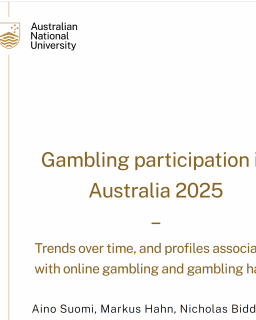
Abstract
Gambling harm remains a major public health issue in Australia, with recent trends showing declining participation yet increasing levels of risky gambling. This study updates national prevalence estimates of gambling participation, risky gambling (PGSI), and affected others using six waves of the ANUpoll survey (2019–2025). Data from January 2025 (n = 3,387) were analysed alongside previous waves to examine patterns across gambling activities, online and venue modes, and demographic and psychosocial profiles. Overall gambling participation slightly declined to 58.8% in 2025, continuing a long-term downward trend. However, risky gambling increased from 13.7% in 2024 to 19.4% 12 months later, by more than five percentage points and almost doubling since the COVID-19 related lock downs 2020-2021. Online gambling increased substantially, with more than half (56.1%) of individuals who gambled mainly participating online in the past 12 months. Sports and race betting were the most heavily online-based activities, while online engagement in electronic gaming machines and casino table games also grew despite legal restrictions. Online gambling were associated with male gender, younger age, higher income, frequent play, psychological distress, and loneliness. Approximately 5.9% of adults reported being harmed by another person’s gambling in the past 12 months. Harm from own or another person’s gambling were associated with younger age, unemployment, parents, lower household incomes, and culturally and linguistically diverse backgrounds. Gambling harm from own and another person’s gambling were also strongly associated with high psychological distress and loneliness. Findings highlight intensifying harm despite declining participation, highlighting a critical need for regulatory and public health responses targeting online gambling.
File attachments
| Attachment | Size |
|---|---|
| Gambling-in-Australia-2025-for-publication-v2.pdf(658.43 KB) | 658.43 KB |